The Impact of AMO Model on Knowledge Sharing in HK Clothing Businesses
VerifiedAdded on 2022/04/26
|228
|61605
|39
Thesis and Dissertation
AI Summary
This doctoral dissertation investigates the impact of the Ability, Motivation, and Opportunity (AMO) model on knowledge sharing within family-controlled businesses (FCBs) in Hong Kong's clothing industry. The study examines how training for workers (ability), incentive systems (motivation), and trust (opportunity) influence knowledge sharing, while also considering the moderating effect of FCBs. The research employs a quantitative approach, analyzing data collected through questionnaires to test hypotheses related to the AMO framework. Findings reveal significant positive impacts of incentive systems and trust on knowledge sharing, but no significant impact for training. The study also explores the negative impact of the AMO components on FCBs. The research provides theoretical and managerial implications, highlighting the importance of strategic focus on AMO components to enhance knowledge sharing performance in the context of FCBs and contributes to the understanding of knowledge management in family businesses, particularly in the Hong Kong clothing sector. The dissertation includes detailed methodology, data analysis, and a discussion of the findings, along with limitations and suggestions for future research.
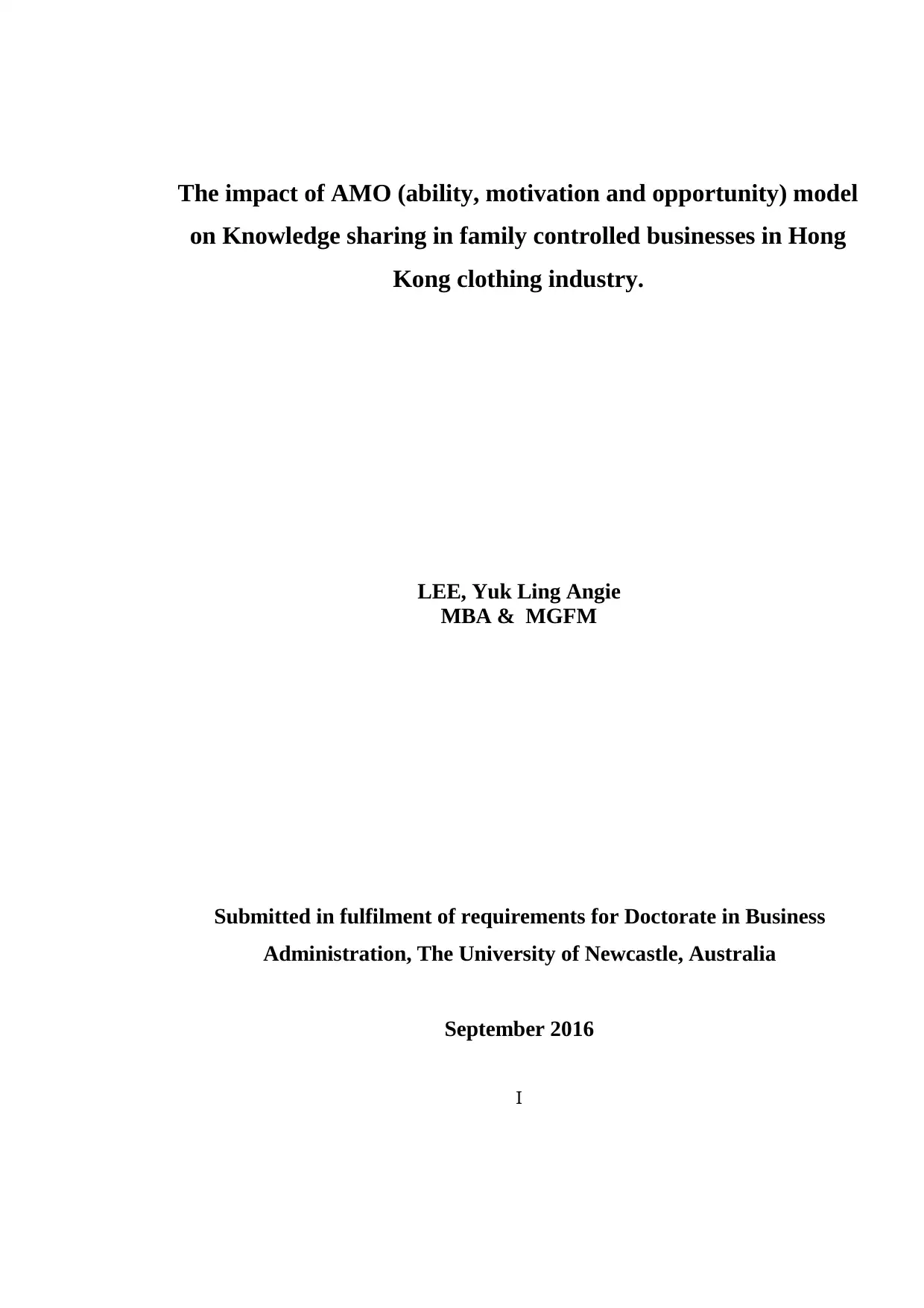
I
The impact of AMO (ability, motivation and opportunity) model
on Knowledge sharing in family controlled businesses in Hong
Kong clothing industry.
LEE, Yuk Ling Angie
MBA & MGFM
Submitted in fulfilment of requirements for Doctorate in Business
Administration, The University of Newcastle, Australia
September 2016
The impact of AMO (ability, motivation and opportunity) model
on Knowledge sharing in family controlled businesses in Hong
Kong clothing industry.
LEE, Yuk Ling Angie
MBA & MGFM
Submitted in fulfilment of requirements for Doctorate in Business
Administration, The University of Newcastle, Australia
September 2016
Paraphrase This Document
Need a fresh take? Get an instant paraphrase of this document with our AI Paraphraser

II
Statement of Originality
The thesis contains no material which has been accepted for the award of any
other degree or diploma in any university or other tertiary institution and, to the best
of my knowledge and belief, contains no material previously published or written by
another person, except where due reference has been made in the text. I give consent
to the final version of my thesis being made available worldwide when deposited in the
University’s Digital Depository**, subject to the provisions of the Copyright Act 1968.
* * U n l e s s a n E m b a r g o h a s b e e n a p p r o v e d f o r a d e t e r m i n e d p e r i o
S i g n a t u r e … … … … … … … … … … … … . . D a t e … … … … … … … … .
Statement of Originality
The thesis contains no material which has been accepted for the award of any
other degree or diploma in any university or other tertiary institution and, to the best
of my knowledge and belief, contains no material previously published or written by
another person, except where due reference has been made in the text. I give consent
to the final version of my thesis being made available worldwide when deposited in the
University’s Digital Depository**, subject to the provisions of the Copyright Act 1968.
* * U n l e s s a n E m b a r g o h a s b e e n a p p r o v e d f o r a d e t e r m i n e d p e r i o
S i g n a t u r e … … … … … … … … … … … … . . D a t e … … … … … … … … .
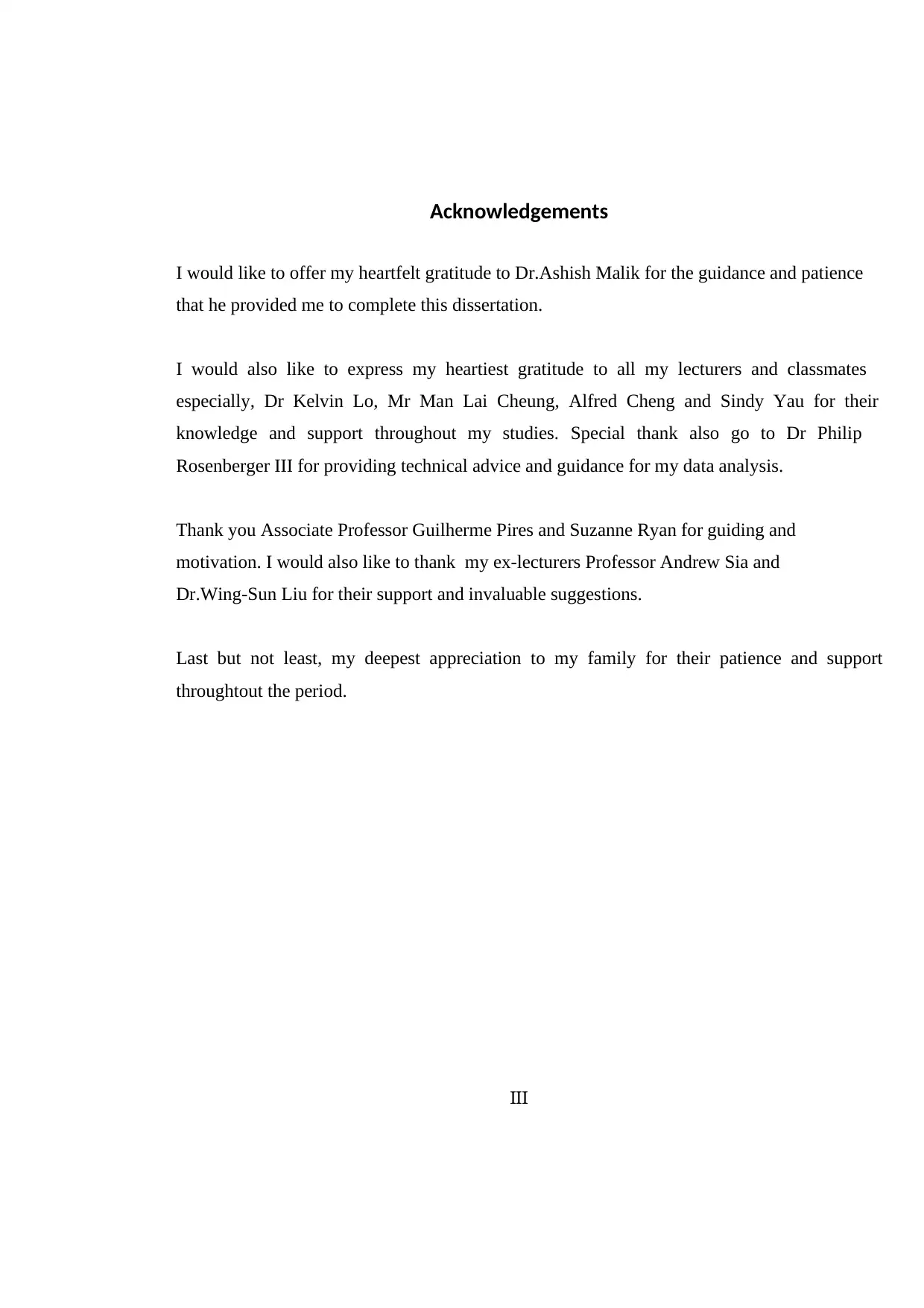
III
Acknowledgements
I would like to offer my heartfelt gratitude to Dr.Ashish Malik for the guidance and patience
that he provided me to complete this dissertation.
I would also like to express my heartiest gratitude to all my lecturers and classmates
especially, Dr Kelvin Lo, Mr Man Lai Cheung, Alfred Cheng and Sindy Yau for their
knowledge and support throughout my studies. Special thank also go to Dr Philip
Rosenberger III for providing technical advice and guidance for my data analysis.
Thank you Associate Professor Guilherme Pires and Suzanne Ryan for guiding and
motivation. I would also like to thank my ex-lecturers Professor Andrew Sia and
Dr.Wing-Sun Liu for their support and invaluable suggestions.
Last but not least, my deepest appreciation to my family for their patience and support
throughtout the period.
Acknowledgements
I would like to offer my heartfelt gratitude to Dr.Ashish Malik for the guidance and patience
that he provided me to complete this dissertation.
I would also like to express my heartiest gratitude to all my lecturers and classmates
especially, Dr Kelvin Lo, Mr Man Lai Cheung, Alfred Cheng and Sindy Yau for their
knowledge and support throughout my studies. Special thank also go to Dr Philip
Rosenberger III for providing technical advice and guidance for my data analysis.
Thank you Associate Professor Guilherme Pires and Suzanne Ryan for guiding and
motivation. I would also like to thank my ex-lecturers Professor Andrew Sia and
Dr.Wing-Sun Liu for their support and invaluable suggestions.
Last but not least, my deepest appreciation to my family for their patience and support
throughtout the period.
⊘ This is a preview!⊘
Do you want full access?
Subscribe today to unlock all pages.

Trusted by 1+ million students worldwide

IV
Content
STATEMENT OF ORIGINALITY ........................................................................................................ II
ACKNOWLEDGEMENTS ................................................................................................................... III
CONTENT ............................................................................................................................................... IV
ABBREVIATIONS ................................................................................................................................ XII
ABSTRACT .......................................................................................................................................... XIII
CHAPTER 1 .............................................................................................................................................. 1
INTRODUCTION ..................................................................................................................................... 1
1.1 INTRODUCTION ..................................................................................................................................................... 1
1.2 STUDY’S BACKGROUND ........................................................................................................................................ 5
1.3 RESEARCH OBJECTIVES ........................................................................................................................................ 5
1.4 RESEARCH PROBLEM AND QUESTIONS .............................................................................................................. 8
1.5 RESEARCH METHOD .......................................................................................................................................... 11
1.5.1 Data analysis ................................................................................................................................................... 11
1.5.2 Structure of the Thesis ................................................................................................................................ 12
1.5.3 Ethical considerations ................................................................................................................................. 12
1.6 EXPECTED CONTRIBUTIONS ............................................................................................................................. 13
1.7 CHAPTER SUMMARY .......................................................................................................................................... 14
CHAPTER 2 ........................................................................................................................................... 16
LITERATURE REVIEW ..................................................................................................................... 16
2.1 INTRODUCTION .................................................................................................................................................. 16
2. 2. KNOWLEDGE MANAGEMENT AND ITS CORE PROCESSES ........................................................................... 17
Content
STATEMENT OF ORIGINALITY ........................................................................................................ II
ACKNOWLEDGEMENTS ................................................................................................................... III
CONTENT ............................................................................................................................................... IV
ABBREVIATIONS ................................................................................................................................ XII
ABSTRACT .......................................................................................................................................... XIII
CHAPTER 1 .............................................................................................................................................. 1
INTRODUCTION ..................................................................................................................................... 1
1.1 INTRODUCTION ..................................................................................................................................................... 1
1.2 STUDY’S BACKGROUND ........................................................................................................................................ 5
1.3 RESEARCH OBJECTIVES ........................................................................................................................................ 5
1.4 RESEARCH PROBLEM AND QUESTIONS .............................................................................................................. 8
1.5 RESEARCH METHOD .......................................................................................................................................... 11
1.5.1 Data analysis ................................................................................................................................................... 11
1.5.2 Structure of the Thesis ................................................................................................................................ 12
1.5.3 Ethical considerations ................................................................................................................................. 12
1.6 EXPECTED CONTRIBUTIONS ............................................................................................................................. 13
1.7 CHAPTER SUMMARY .......................................................................................................................................... 14
CHAPTER 2 ........................................................................................................................................... 16
LITERATURE REVIEW ..................................................................................................................... 16
2.1 INTRODUCTION .................................................................................................................................................. 16
2. 2. KNOWLEDGE MANAGEMENT AND ITS CORE PROCESSES ........................................................................... 17
Paraphrase This Document
Need a fresh take? Get an instant paraphrase of this document with our AI Paraphraser
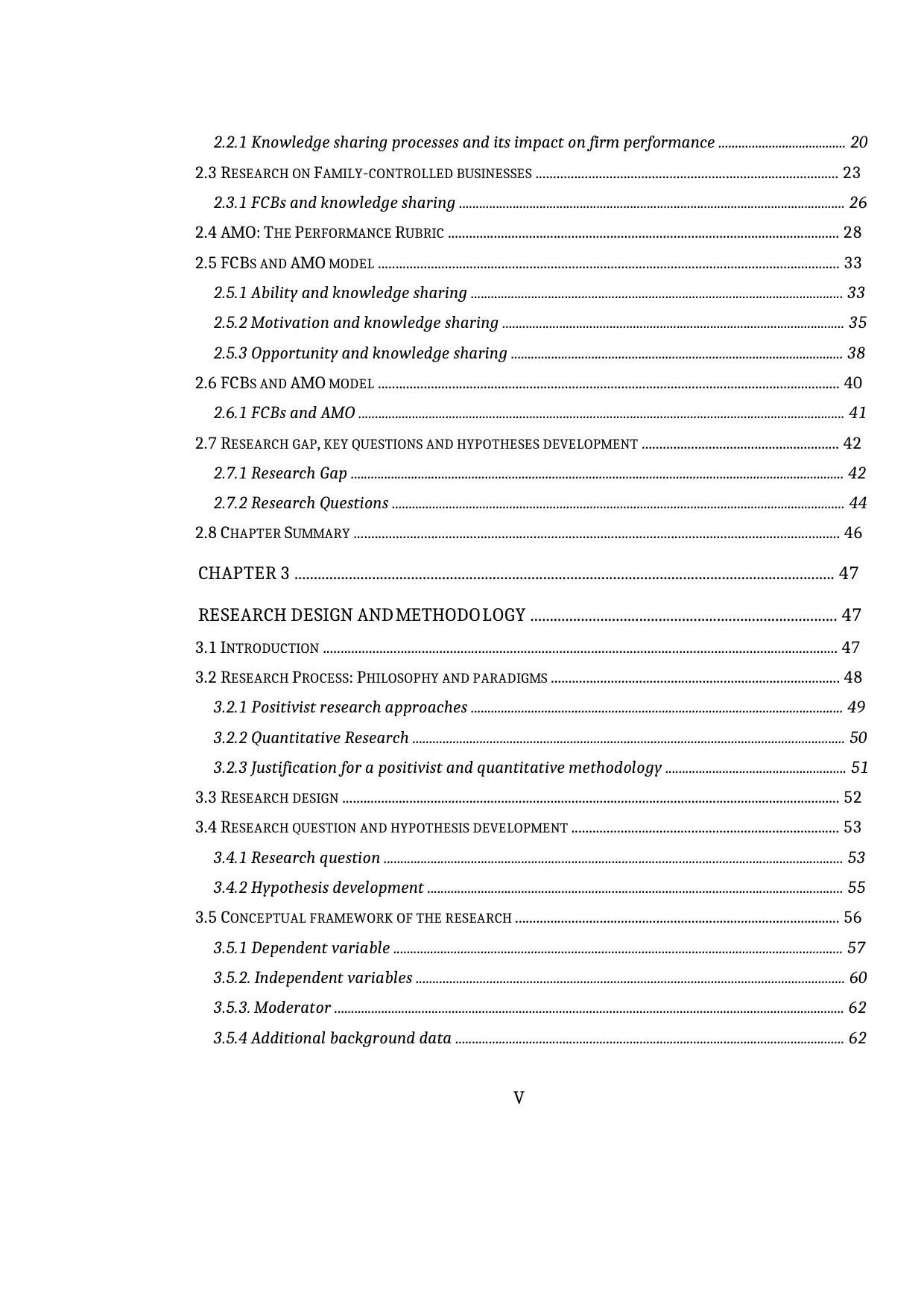
V
2.2.1 Knowledge sharing processes and its impact on firm performance ...................................... 20
2.3 RESEARCH ON FAMILY-CONTROLLED BUSINESSES ...................................................................................... 23
2.3.1 FCBs and knowledge sharing ................................................................................................................... 26
2.4 AMO: THE PERFORMANCE RUBRIC ............................................................................................................... 28
2.5 FCBS AND AMO MODEL ................................................................................................................................... 33
2.5.1 Ability and knowledge sharing ............................................................................................................... 33
2.5.2 Motivation and knowledge sharing ...................................................................................................... 35
2.5.3 Opportunity and knowledge sharing ................................................................................................... 38
2.6 FCBS AND AMO MODEL ................................................................................................................................... 40
2.6.1 FCBs and AMO ................................................................................................................................................. 41
2.7 RESEARCH GAP, KEY QUESTIONS AND HYPOTHESES DEVELOPMENT ........................................................ 42
2.7.1 Research Gap ................................................................................................................................................... 42
2.7.2 Research Questions ....................................................................................................................................... 44
2.8 CHAPTER SUMMARY .......................................................................................................................................... 46
CHAPTER 3 ........................................................................................................................................... 47
RESEARCH DESIGN AND METHODOL OGY ............................................................................... 47
3.1 INTRODUCTION .................................................................................................................................................. 47
3.2 RESEARCH PROCESS: PHILOSOPHY AND PARADIGMS .................................................................................. 48
3.2.1 Positivist research approaches ............................................................................................................... 49
3.2.2 Quantitative Research ................................................................................................................................. 50
3.2.3 Justification for a positivist and quantitative methodology ...................................................... 51
3.3 RESEARCH DESIGN ............................................................................................................................................. 52
3.4 RESEARCH QUESTION AND HYPOTHESIS DEVELOPMENT ............................................................................ 53
3.4.1 Research question ......................................................................................................................................... 53
3.4.2 Hypothesis development ............................................................................................................................ 55
3.5 CONCEPTUAL FRAMEWORK OF THE RESEARCH ............................................................................................ 56
3.5.1 Dependent variable ...................................................................................................................................... 57
3.5.2. Independent variables ................................................................................................................................ 60
3.5.3. Moderator ........................................................................................................................................................ 62
3.5.4 Additional background data .................................................................................................................... 62
2.2.1 Knowledge sharing processes and its impact on firm performance ...................................... 20
2.3 RESEARCH ON FAMILY-CONTROLLED BUSINESSES ...................................................................................... 23
2.3.1 FCBs and knowledge sharing ................................................................................................................... 26
2.4 AMO: THE PERFORMANCE RUBRIC ............................................................................................................... 28
2.5 FCBS AND AMO MODEL ................................................................................................................................... 33
2.5.1 Ability and knowledge sharing ............................................................................................................... 33
2.5.2 Motivation and knowledge sharing ...................................................................................................... 35
2.5.3 Opportunity and knowledge sharing ................................................................................................... 38
2.6 FCBS AND AMO MODEL ................................................................................................................................... 40
2.6.1 FCBs and AMO ................................................................................................................................................. 41
2.7 RESEARCH GAP, KEY QUESTIONS AND HYPOTHESES DEVELOPMENT ........................................................ 42
2.7.1 Research Gap ................................................................................................................................................... 42
2.7.2 Research Questions ....................................................................................................................................... 44
2.8 CHAPTER SUMMARY .......................................................................................................................................... 46
CHAPTER 3 ........................................................................................................................................... 47
RESEARCH DESIGN AND METHODOL OGY ............................................................................... 47
3.1 INTRODUCTION .................................................................................................................................................. 47
3.2 RESEARCH PROCESS: PHILOSOPHY AND PARADIGMS .................................................................................. 48
3.2.1 Positivist research approaches ............................................................................................................... 49
3.2.2 Quantitative Research ................................................................................................................................. 50
3.2.3 Justification for a positivist and quantitative methodology ...................................................... 51
3.3 RESEARCH DESIGN ............................................................................................................................................. 52
3.4 RESEARCH QUESTION AND HYPOTHESIS DEVELOPMENT ............................................................................ 53
3.4.1 Research question ......................................................................................................................................... 53
3.4.2 Hypothesis development ............................................................................................................................ 55
3.5 CONCEPTUAL FRAMEWORK OF THE RESEARCH ............................................................................................ 56
3.5.1 Dependent variable ...................................................................................................................................... 57
3.5.2. Independent variables ................................................................................................................................ 60
3.5.3. Moderator ........................................................................................................................................................ 62
3.5.4 Additional background data .................................................................................................................... 62
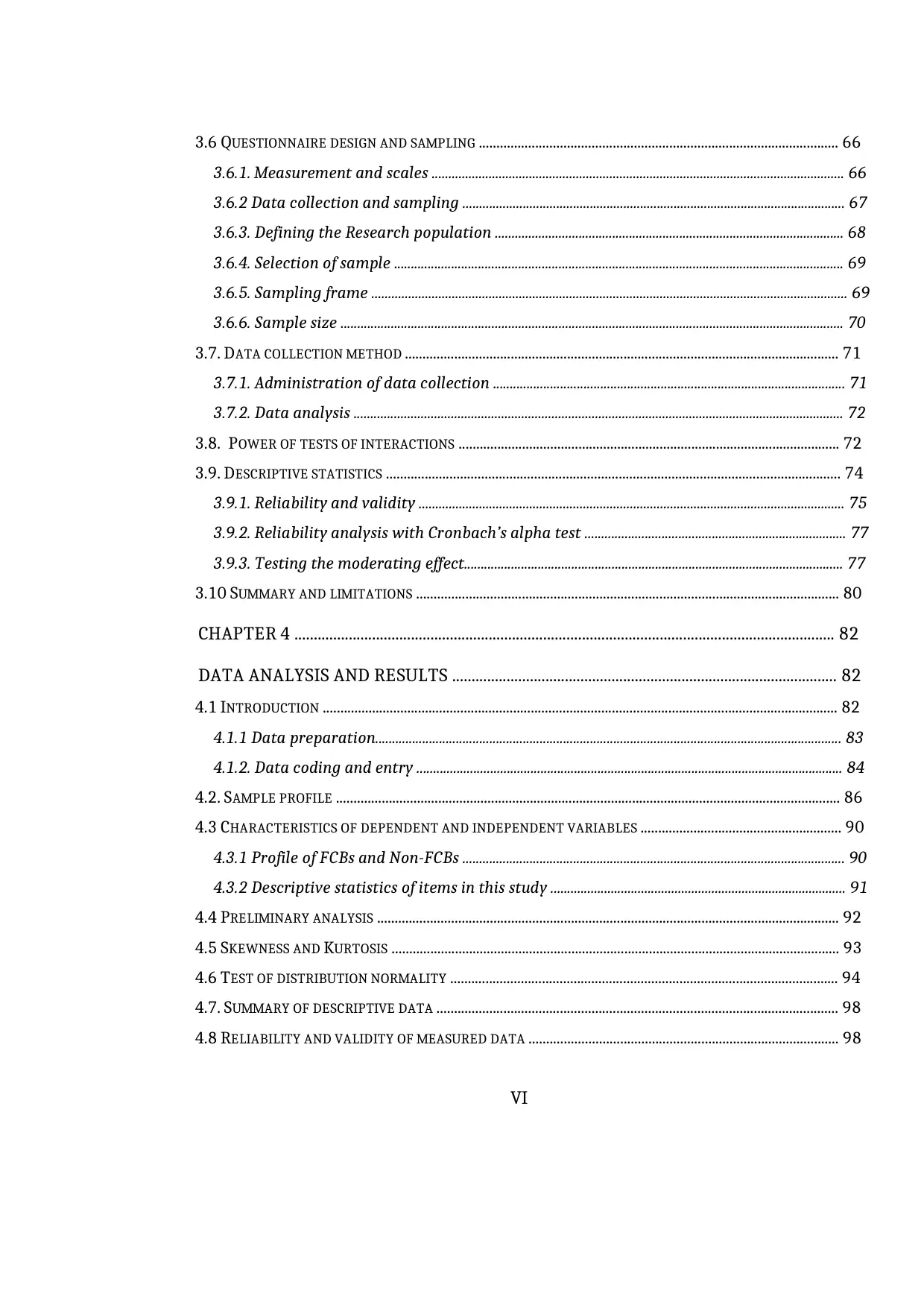
VI
3.6 QUESTIONNAIRE DESIGN AND SAMPLING ...................................................................................................... 66
3.6.1. Measurement and scales ........................................................................................................................... 66
3.6.2 Data collection and sampling .................................................................................................................. 67
3.6.3. Defining the Research population ........................................................................................................ 68
3.6.4. Selection of sample ...................................................................................................................................... 69
3.6.5. Sampling frame .............................................................................................................................................. 69
3.6.6. Sample size ...................................................................................................................................................... 70
3.7. DATA COLLECTION METHOD ........................................................................................................................... 71
3.7.1. Administration of data collection ......................................................................................................... 71
3.7.2. Data analysis .................................................................................................................................................. 72
3.8. POWER OF TESTS OF INTERACTIONS ............................................................................................................ 72
3.9. DESCRIPTIVE STATISTICS ................................................................................................................................. 74
3.9.1. Reliability and validity ............................................................................................................................... 75
3.9.2. Reliability analysis with Cronbach’s alpha test .............................................................................. 77
3.9.3. Testing the moderating effect................................................................................................................. 77
3.10 SUMMARY AND LIMITATIONS ........................................................................................................................ 80
CHAPTER 4 ........................................................................................................................................... 82
DATA ANALYSIS AND RESULTS ................................................................................................... 82
4.1 INTRODUCTION .................................................................................................................................................. 82
4.1.1 Data preparation........................................................................................................................................... 83
4.1.2. Data coding and entry ............................................................................................................................... 84
4.2. SAMPLE PROFILE ............................................................................................................................................... 86
4.3 CHARACTERISTICS OF DEPENDENT AND INDEPENDENT VARIABLES ......................................................... 90
4.3.1 Profile of FCBs and Non-FCBs .................................................................................................................. 90
4.3.2 Descriptive statistics of items in this study ........................................................................................ 91
4.4 PRELIMINARY ANALYSIS ................................................................................................................................... 92
4.5 SKEWNESS AND KURTOSIS ............................................................................................................................... 93
4.6 TEST OF DISTRIBUTION NORMALITY .............................................................................................................. 94
4.7. SUMMARY OF DESCRIPTIVE DATA .................................................................................................................. 98
4.8 RELIABILITY AND VALIDITY OF MEASURED DATA ........................................................................................ 98
3.6 QUESTIONNAIRE DESIGN AND SAMPLING ...................................................................................................... 66
3.6.1. Measurement and scales ........................................................................................................................... 66
3.6.2 Data collection and sampling .................................................................................................................. 67
3.6.3. Defining the Research population ........................................................................................................ 68
3.6.4. Selection of sample ...................................................................................................................................... 69
3.6.5. Sampling frame .............................................................................................................................................. 69
3.6.6. Sample size ...................................................................................................................................................... 70
3.7. DATA COLLECTION METHOD ........................................................................................................................... 71
3.7.1. Administration of data collection ......................................................................................................... 71
3.7.2. Data analysis .................................................................................................................................................. 72
3.8. POWER OF TESTS OF INTERACTIONS ............................................................................................................ 72
3.9. DESCRIPTIVE STATISTICS ................................................................................................................................. 74
3.9.1. Reliability and validity ............................................................................................................................... 75
3.9.2. Reliability analysis with Cronbach’s alpha test .............................................................................. 77
3.9.3. Testing the moderating effect................................................................................................................. 77
3.10 SUMMARY AND LIMITATIONS ........................................................................................................................ 80
CHAPTER 4 ........................................................................................................................................... 82
DATA ANALYSIS AND RESULTS ................................................................................................... 82
4.1 INTRODUCTION .................................................................................................................................................. 82
4.1.1 Data preparation........................................................................................................................................... 83
4.1.2. Data coding and entry ............................................................................................................................... 84
4.2. SAMPLE PROFILE ............................................................................................................................................... 86
4.3 CHARACTERISTICS OF DEPENDENT AND INDEPENDENT VARIABLES ......................................................... 90
4.3.1 Profile of FCBs and Non-FCBs .................................................................................................................. 90
4.3.2 Descriptive statistics of items in this study ........................................................................................ 91
4.4 PRELIMINARY ANALYSIS ................................................................................................................................... 92
4.5 SKEWNESS AND KURTOSIS ............................................................................................................................... 93
4.6 TEST OF DISTRIBUTION NORMALITY .............................................................................................................. 94
4.7. SUMMARY OF DESCRIPTIVE DATA .................................................................................................................. 98
4.8 RELIABILITY AND VALIDITY OF MEASURED DATA ........................................................................................ 98
⊘ This is a preview!⊘
Do you want full access?
Subscribe today to unlock all pages.

Trusted by 1+ million students worldwide

VII
4.8.1. Validity of measured data ........................................................................................................................ 98
4.8.2. Validity of independent and dependent variables ........................................................................ 99
4.9. RELIABILITY ANALYSIS .................................................................................................................................. 101
4.9.1. Ability (Training for Workers) ............................................................................................................ 101
4.9.2. Motivation (Incentive Systems) .......................................................................................................... 101
4.9.3. Opportunity (Trust) ................................................................................................................................. 102
4.9.4. Knowledge Sharing .................................................................................................................................. 102
4.9.5 Discriminant and Construct validity ................................................................................................. 103
4.10. HYPOTHESIS TESTING ................................................................................................................................. 104
4.10.1 Hypothesis 1.1 ........................................................................................................................................... 108
4.10.2 Hypothesis 1.2 ........................................................................................................................................... 108
4.10.3 Hypothesis 1.3 ........................................................................................................................................... 109
4.11. PROCESS MACRO IN SPSS FOR B ANALYSIS ............................................................................................. 110
4.11.1. Hypothesis 2.1 .......................................................................................................................................... 111
4.11.2. Hypothesis 2.2 .......................................................................................................................................... 113
4.11.3. Hypothesis 2.3 (H2.3) ............................................................................................................................ 117
4.12 SIMPLE SLOPE ANALYSIS .............................................................................................................................. 120
4.13 SUMMARY OF HYPOTHESIS TESTING .......................................................................................................... 121
4.14 CHAPTER SUMMARY ..................................................................................................................................... 122
CHAPTER 5 ......................................................................................................................................... 124
DISCUSSION AND CONCLUSION ................................................................................................ 124
5.1 INTRODUCTION ................................................................................................................................................ 124
5.2 MAJOR FINDINGS .............................................................................................................................................. 124
5.3 RESEARCH FRAMEWORK ................................................................................................................................ 125
5.4. DISCUSSION OF FINDINGS .............................................................................................................................. 126
5.5 MODERATING EFFECT OF FCBS .................................................................................................................... 129
5.6 THEORETICAL IMPLICATIONS ........................................................................................................................ 132
5.7 MANAGERIAL IMPLICATIONS ......................................................................................................................... 134
5.8 CONTRIBUTIONS .............................................................................................................................................. 136
5.9 LIMITATIONS AND FUTURE RESEARCH ......................................................................................................... 137
4.8.1. Validity of measured data ........................................................................................................................ 98
4.8.2. Validity of independent and dependent variables ........................................................................ 99
4.9. RELIABILITY ANALYSIS .................................................................................................................................. 101
4.9.1. Ability (Training for Workers) ............................................................................................................ 101
4.9.2. Motivation (Incentive Systems) .......................................................................................................... 101
4.9.3. Opportunity (Trust) ................................................................................................................................. 102
4.9.4. Knowledge Sharing .................................................................................................................................. 102
4.9.5 Discriminant and Construct validity ................................................................................................. 103
4.10. HYPOTHESIS TESTING ................................................................................................................................. 104
4.10.1 Hypothesis 1.1 ........................................................................................................................................... 108
4.10.2 Hypothesis 1.2 ........................................................................................................................................... 108
4.10.3 Hypothesis 1.3 ........................................................................................................................................... 109
4.11. PROCESS MACRO IN SPSS FOR B ANALYSIS ............................................................................................. 110
4.11.1. Hypothesis 2.1 .......................................................................................................................................... 111
4.11.2. Hypothesis 2.2 .......................................................................................................................................... 113
4.11.3. Hypothesis 2.3 (H2.3) ............................................................................................................................ 117
4.12 SIMPLE SLOPE ANALYSIS .............................................................................................................................. 120
4.13 SUMMARY OF HYPOTHESIS TESTING .......................................................................................................... 121
4.14 CHAPTER SUMMARY ..................................................................................................................................... 122
CHAPTER 5 ......................................................................................................................................... 124
DISCUSSION AND CONCLUSION ................................................................................................ 124
5.1 INTRODUCTION ................................................................................................................................................ 124
5.2 MAJOR FINDINGS .............................................................................................................................................. 124
5.3 RESEARCH FRAMEWORK ................................................................................................................................ 125
5.4. DISCUSSION OF FINDINGS .............................................................................................................................. 126
5.5 MODERATING EFFECT OF FCBS .................................................................................................................... 129
5.6 THEORETICAL IMPLICATIONS ........................................................................................................................ 132
5.7 MANAGERIAL IMPLICATIONS ......................................................................................................................... 134
5.8 CONTRIBUTIONS .............................................................................................................................................. 136
5.9 LIMITATIONS AND FUTURE RESEARCH ......................................................................................................... 137
Paraphrase This Document
Need a fresh take? Get an instant paraphrase of this document with our AI Paraphraser
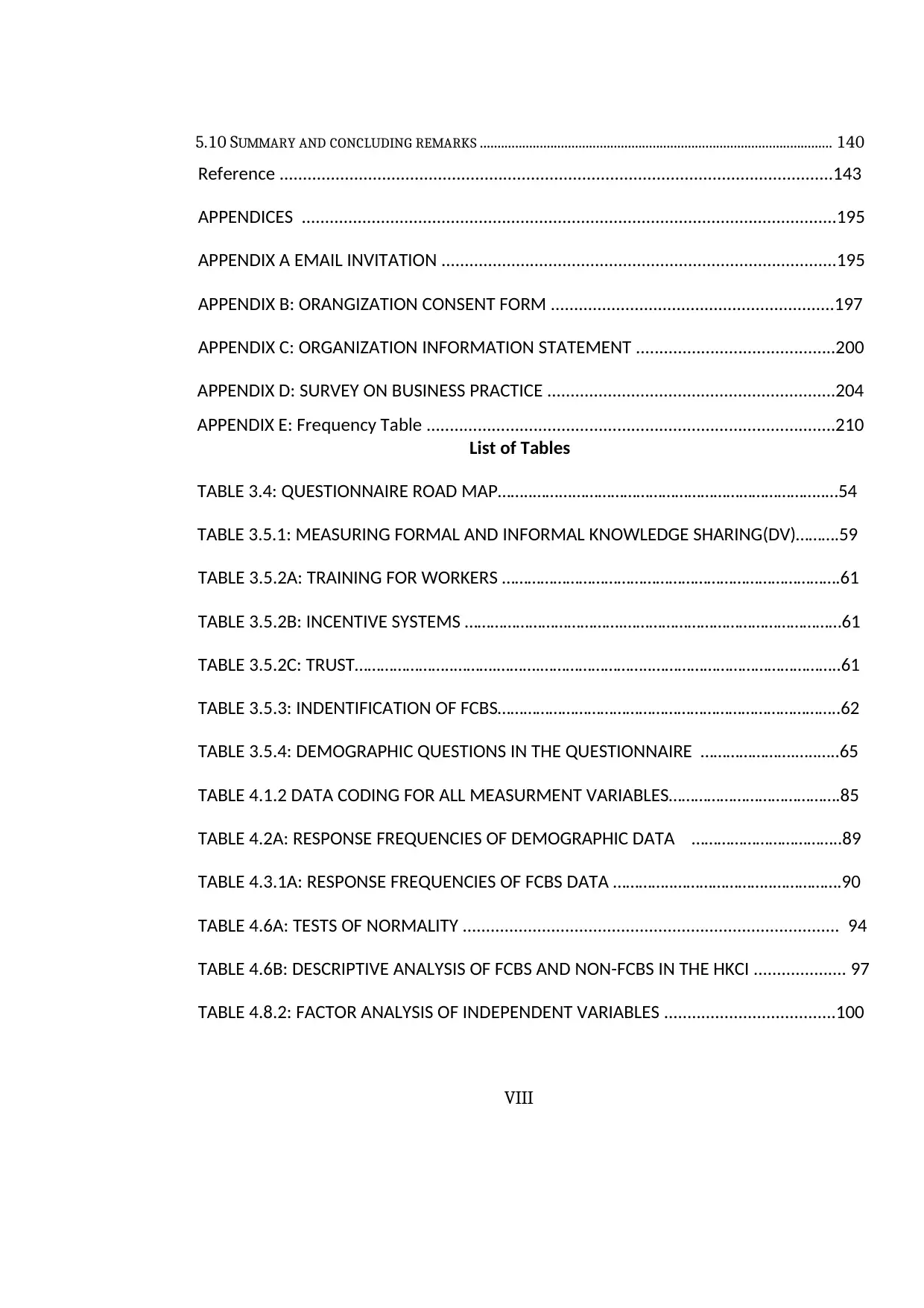
VIII
5.10 SUMMARY AND CONCLUDING REMARKS .................................................................................................... 140
Reference .......................................................................................................................143
APPENDICES ...................................................................................................................195
APPENDIX A EMAIL INVITATION .....................................................................................195
APPENDIX B: ORANGIZATION CONSENT FORM .............................................................197
APPENDIX C: ORGANIZATION INFORMATION STATEMENT ...........................................200
APPENDIX D: SURVEY ON BUSINESS PRACTICE ..............................................................204
APPENDIX E: Frequency Table ........................................................................................210
List of Tables
TABLE 3.4: QUESTIONNAIRE ROAD MAP……..……...…………………………………………………..…54
TABLE 3.5.1: MEASURING FORMAL AND INFORMAL KNOWLEDGE SHARING(DV)……….59
TABLE 3.5.2A: TRAINING FOR WORKERS …………………………………………………………………….61
TABLE 3.5.2B: INCENTIVE SYSTEMS ……………………………….……………………………………………61
TABLE 3.5.2C: TRUST…………………..……….……….……………………..……………………………………..61
TABLE 3.5.3: INDENTIFICATION OF FCBS……………………………………………………………………..62
TABLE 3.5.4: DEMOGRAPHIC QUESTIONS IN THE QUESTIONNAIRE ………………….…..…..65
TABLE 4.1.2 DATA CODING FOR ALL MEASURMENT VARIABLES………………………………….85
TABLE 4.2A: RESPONSE FREQUENCIES OF DEMOGRAPHIC DATA ……………………………..89
TABLE 4.3.1A: RESPONSE FREQUENCIES OF FCBS DATA …………..…………………..…………….90
TABLE 4.6A: TESTS OF NORMALITY ................................................................................. 94
TABLE 4.6B: DESCRIPTIVE ANALYSIS OF FCBS AND NON-FCBS IN THE HKCI .................... 97
TABLE 4.8.2: FACTOR ANALYSIS OF INDEPENDENT VARIABLES .....................................100
5.10 SUMMARY AND CONCLUDING REMARKS .................................................................................................... 140
Reference .......................................................................................................................143
APPENDICES ...................................................................................................................195
APPENDIX A EMAIL INVITATION .....................................................................................195
APPENDIX B: ORANGIZATION CONSENT FORM .............................................................197
APPENDIX C: ORGANIZATION INFORMATION STATEMENT ...........................................200
APPENDIX D: SURVEY ON BUSINESS PRACTICE ..............................................................204
APPENDIX E: Frequency Table ........................................................................................210
List of Tables
TABLE 3.4: QUESTIONNAIRE ROAD MAP……..……...…………………………………………………..…54
TABLE 3.5.1: MEASURING FORMAL AND INFORMAL KNOWLEDGE SHARING(DV)……….59
TABLE 3.5.2A: TRAINING FOR WORKERS …………………………………………………………………….61
TABLE 3.5.2B: INCENTIVE SYSTEMS ……………………………….……………………………………………61
TABLE 3.5.2C: TRUST…………………..……….……….……………………..……………………………………..61
TABLE 3.5.3: INDENTIFICATION OF FCBS……………………………………………………………………..62
TABLE 3.5.4: DEMOGRAPHIC QUESTIONS IN THE QUESTIONNAIRE ………………….…..…..65
TABLE 4.1.2 DATA CODING FOR ALL MEASURMENT VARIABLES………………………………….85
TABLE 4.2A: RESPONSE FREQUENCIES OF DEMOGRAPHIC DATA ……………………………..89
TABLE 4.3.1A: RESPONSE FREQUENCIES OF FCBS DATA …………..…………………..…………….90
TABLE 4.6A: TESTS OF NORMALITY ................................................................................. 94
TABLE 4.6B: DESCRIPTIVE ANALYSIS OF FCBS AND NON-FCBS IN THE HKCI .................... 97
TABLE 4.8.2: FACTOR ANALYSIS OF INDEPENDENT VARIABLES .....................................100

IX
TABLE 4.9.5: CORRELATIONS OF FACTORS IN THIS STUDY ..........................................104
TABLE 4.10A: MULTICOLLINEARITY TEST RESULTS IN MODEL 1 ....................................105
TABLE 4.10B: MULTICOLLINEARITY TEST RESULTS IN MODEL 2 ....................................106
TABLE 4.10.3: MODEL SUMMARY ..................................................................................110
TABLE 4.11.1A: MODEL SUMMARY IN BETWEEN TRAINING FOR WORKERS IN FCBS ...111
TABLE 4.11.1B: CONDITIONAL EFFECT OF TRAINING FOR WORKERS(X) AND
KNOWLEDGE SHARING(Y) AT VALUES OF FCBS (M) …..…………................................ 112
TABLE 4.11.1C: CONDITIONAL EFFECT OF TRAINING FOR WORKERS(X) AND
KNOWLEDGE SHARING(Y) AT VALUES OF FCBS (M) (JOHNSON-NEYMAN SIGNIFICANCE
REGIONS(S) ……………………………………………………………………………………........................... 113
TABLE 4.11.2A: MODEL SUMMARY IN BETWEEN INCENTIVE SYSTEMS IN FCBS ...........114
TABLE 4.11.2B: CONDITIONAL EFFECT OF INCENTIVE SYSTEMS(X) AND
KNOWLEDGE SHARING(Y) AT VALUES OF FCBS (M) …..………….................................. 115
TABLE 4.11.2C: CONDITIONAL EFFECT OF INCENTIVE SYSTEMS (X) AND
KNOWLEDGE SHARING(Y) AT VALUES OF FCBS (M) (JOHNSON-NEYMAN SIGNIFICANCE
REGIONS(S) ………………………………………………………………….…………………....................... 116
TABLE 4.11.3A: MODEL SUMMARY IN BETWEEN TRUST IN FCBS..................................117
TABLE 4.11.3B: CONDITIONAL EFFECT OF TRUST (X) AND KNOWLEDGE SHARING(Y) AT
VALUES OF FCBS (M) ………………………………………………....………….................................. 118
TABLE 4.11.3C: CONDITIONAL EFFECT OF TRUST(X) AND KNOWLEDGE SHARING(Y) AT
TABLE 4.9.5: CORRELATIONS OF FACTORS IN THIS STUDY ..........................................104
TABLE 4.10A: MULTICOLLINEARITY TEST RESULTS IN MODEL 1 ....................................105
TABLE 4.10B: MULTICOLLINEARITY TEST RESULTS IN MODEL 2 ....................................106
TABLE 4.10.3: MODEL SUMMARY ..................................................................................110
TABLE 4.11.1A: MODEL SUMMARY IN BETWEEN TRAINING FOR WORKERS IN FCBS ...111
TABLE 4.11.1B: CONDITIONAL EFFECT OF TRAINING FOR WORKERS(X) AND
KNOWLEDGE SHARING(Y) AT VALUES OF FCBS (M) …..…………................................ 112
TABLE 4.11.1C: CONDITIONAL EFFECT OF TRAINING FOR WORKERS(X) AND
KNOWLEDGE SHARING(Y) AT VALUES OF FCBS (M) (JOHNSON-NEYMAN SIGNIFICANCE
REGIONS(S) ……………………………………………………………………………………........................... 113
TABLE 4.11.2A: MODEL SUMMARY IN BETWEEN INCENTIVE SYSTEMS IN FCBS ...........114
TABLE 4.11.2B: CONDITIONAL EFFECT OF INCENTIVE SYSTEMS(X) AND
KNOWLEDGE SHARING(Y) AT VALUES OF FCBS (M) …..………….................................. 115
TABLE 4.11.2C: CONDITIONAL EFFECT OF INCENTIVE SYSTEMS (X) AND
KNOWLEDGE SHARING(Y) AT VALUES OF FCBS (M) (JOHNSON-NEYMAN SIGNIFICANCE
REGIONS(S) ………………………………………………………………….…………………....................... 116
TABLE 4.11.3A: MODEL SUMMARY IN BETWEEN TRUST IN FCBS..................................117
TABLE 4.11.3B: CONDITIONAL EFFECT OF TRUST (X) AND KNOWLEDGE SHARING(Y) AT
VALUES OF FCBS (M) ………………………………………………....………….................................. 118
TABLE 4.11.3C: CONDITIONAL EFFECT OF TRUST(X) AND KNOWLEDGE SHARING(Y) AT
⊘ This is a preview!⊘
Do you want full access?
Subscribe today to unlock all pages.

Trusted by 1+ million students worldwide
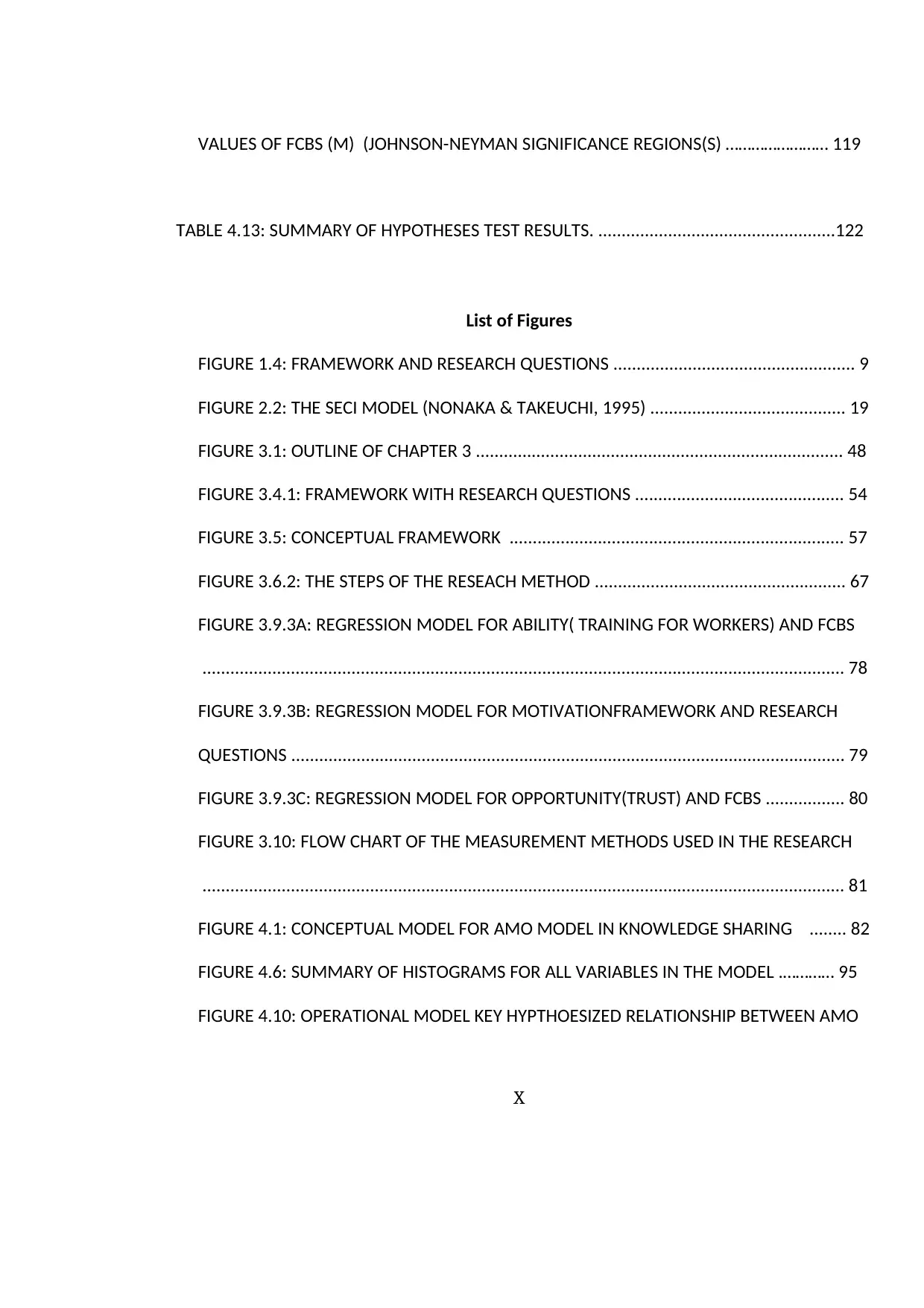
X
VALUES OF FCBS (M) (JOHNSON-NEYMAN SIGNIFICANCE REGIONS(S) …………………… 119
TABLE 4.13: SUMMARY OF HYPOTHESES TEST RESULTS. ...................................................122
List of Figures
FIGURE 1.4: FRAMEWORK AND RESEARCH QUESTIONS .................................................... 9
FIGURE 2.2: THE SECI MODEL (NONAKA & TAKEUCHI, 1995) .......................................... 19
FIGURE 3.1: OUTLINE OF CHAPTER 3 ............................................................................... 48
FIGURE 3.4.1: FRAMEWORK WITH RESEARCH QUESTIONS ............................................. 54
FIGURE 3.5: CONCEPTUAL FRAMEWORK ........................................................................ 57
FIGURE 3.6.2: THE STEPS OF THE RESEACH METHOD ...................................................... 67
FIGURE 3.9.3A: REGRESSION MODEL FOR ABILITY( TRAINING FOR WORKERS) AND FCBS
.......................................................................................................................................... 78
FIGURE 3.9.3B: REGRESSION MODEL FOR MOTIVATIONFRAMEWORK AND RESEARCH
QUESTIONS ....................................................................................................................... 79
FIGURE 3.9.3C: REGRESSION MODEL FOR OPPORTUNITY(TRUST) AND FCBS ................. 80
FIGURE 3.10: FLOW CHART OF THE MEASUREMENT METHODS USED IN THE RESEARCH
.......................................................................................................................................... 81
FIGURE 4.1: CONCEPTUAL MODEL FOR AMO MODEL IN KNOWLEDGE SHARING ........ 82
FIGURE 4.6: SUMMARY OF HISTOGRAMS FOR ALL VARIABLES IN THE MODEL .………… 95
FIGURE 4.10: OPERATIONAL MODEL KEY HYPTHOESIZED RELATIONSHIP BETWEEN AMO
VALUES OF FCBS (M) (JOHNSON-NEYMAN SIGNIFICANCE REGIONS(S) …………………… 119
TABLE 4.13: SUMMARY OF HYPOTHESES TEST RESULTS. ...................................................122
List of Figures
FIGURE 1.4: FRAMEWORK AND RESEARCH QUESTIONS .................................................... 9
FIGURE 2.2: THE SECI MODEL (NONAKA & TAKEUCHI, 1995) .......................................... 19
FIGURE 3.1: OUTLINE OF CHAPTER 3 ............................................................................... 48
FIGURE 3.4.1: FRAMEWORK WITH RESEARCH QUESTIONS ............................................. 54
FIGURE 3.5: CONCEPTUAL FRAMEWORK ........................................................................ 57
FIGURE 3.6.2: THE STEPS OF THE RESEACH METHOD ...................................................... 67
FIGURE 3.9.3A: REGRESSION MODEL FOR ABILITY( TRAINING FOR WORKERS) AND FCBS
.......................................................................................................................................... 78
FIGURE 3.9.3B: REGRESSION MODEL FOR MOTIVATIONFRAMEWORK AND RESEARCH
QUESTIONS ....................................................................................................................... 79
FIGURE 3.9.3C: REGRESSION MODEL FOR OPPORTUNITY(TRUST) AND FCBS ................. 80
FIGURE 3.10: FLOW CHART OF THE MEASUREMENT METHODS USED IN THE RESEARCH
.......................................................................................................................................... 81
FIGURE 4.1: CONCEPTUAL MODEL FOR AMO MODEL IN KNOWLEDGE SHARING ........ 82
FIGURE 4.6: SUMMARY OF HISTOGRAMS FOR ALL VARIABLES IN THE MODEL .………… 95
FIGURE 4.10: OPERATIONAL MODEL KEY HYPTHOESIZED RELATIONSHIP BETWEEN AMO
Paraphrase This Document
Need a fresh take? Get an instant paraphrase of this document with our AI Paraphraser
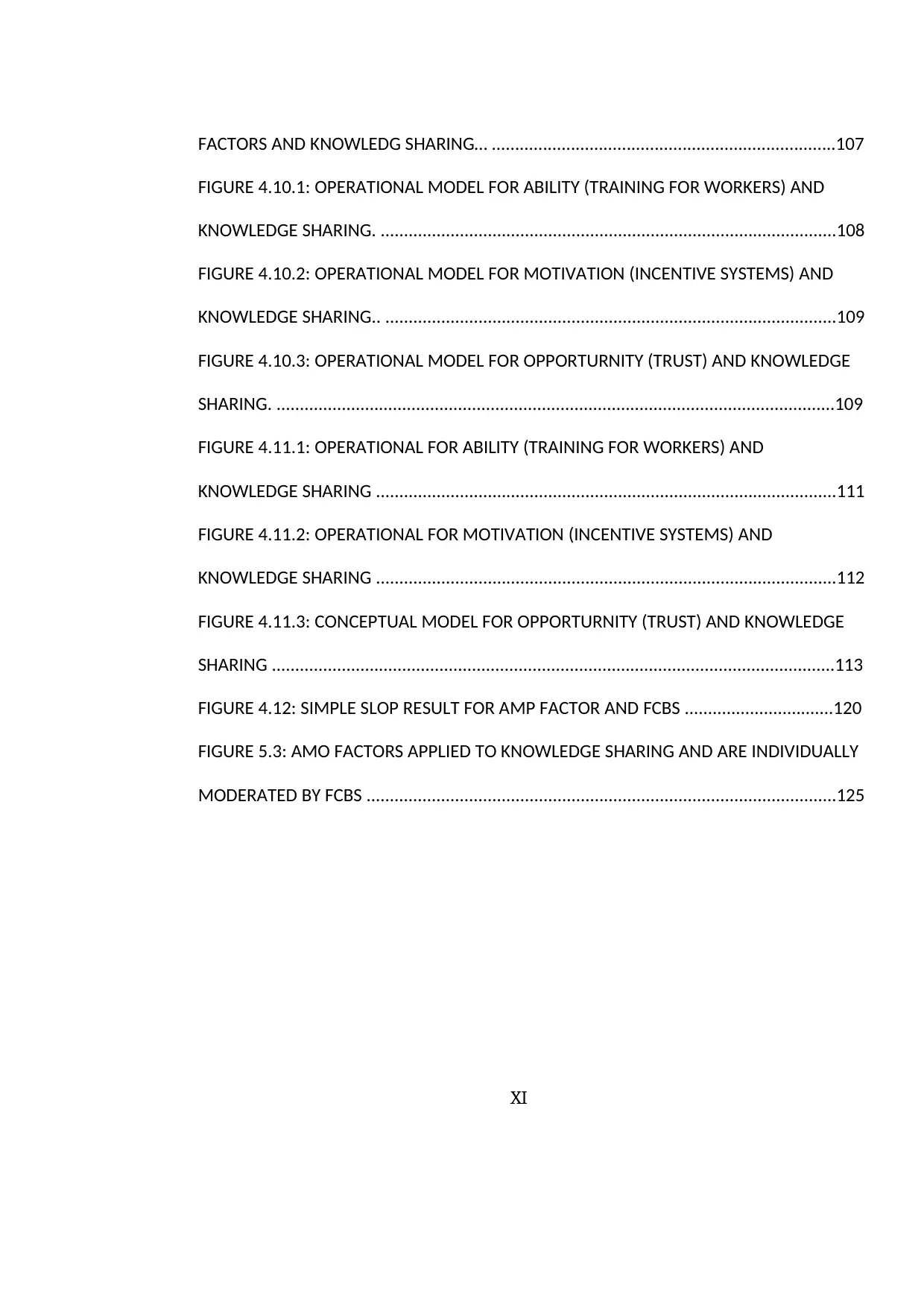
XI
FACTORS AND KNOWLEDG SHARING… ..........................................................................107
FIGURE 4.10.1: OPERATIONAL MODEL FOR ABILITY (TRAINING FOR WORKERS) AND
KNOWLEDGE SHARING. ..................................................................................................108
FIGURE 4.10.2: OPERATIONAL MODEL FOR MOTIVATION (INCENTIVE SYSTEMS) AND
KNOWLEDGE SHARING.. .................................................................................................109
FIGURE 4.10.3: OPERATIONAL MODEL FOR OPPORTURNITY (TRUST) AND KNOWLEDGE
SHARING. ........................................................................................................................109
FIGURE 4.11.1: OPERATIONAL FOR ABILITY (TRAINING FOR WORKERS) AND
KNOWLEDGE SHARING ...................................................................................................111
FIGURE 4.11.2: OPERATIONAL FOR MOTIVATION (INCENTIVE SYSTEMS) AND
KNOWLEDGE SHARING ...................................................................................................112
FIGURE 4.11.3: CONCEPTUAL MODEL FOR OPPORTURNITY (TRUST) AND KNOWLEDGE
SHARING .........................................................................................................................113
FIGURE 4.12: SIMPLE SLOP RESULT FOR AMP FACTOR AND FCBS ................................120
FIGURE 5.3: AMO FACTORS APPLIED TO KNOWLEDGE SHARING AND ARE INDIVIDUALLY
MODERATED BY FCBS .....................................................................................................125
FACTORS AND KNOWLEDG SHARING… ..........................................................................107
FIGURE 4.10.1: OPERATIONAL MODEL FOR ABILITY (TRAINING FOR WORKERS) AND
KNOWLEDGE SHARING. ..................................................................................................108
FIGURE 4.10.2: OPERATIONAL MODEL FOR MOTIVATION (INCENTIVE SYSTEMS) AND
KNOWLEDGE SHARING.. .................................................................................................109
FIGURE 4.10.3: OPERATIONAL MODEL FOR OPPORTURNITY (TRUST) AND KNOWLEDGE
SHARING. ........................................................................................................................109
FIGURE 4.11.1: OPERATIONAL FOR ABILITY (TRAINING FOR WORKERS) AND
KNOWLEDGE SHARING ...................................................................................................111
FIGURE 4.11.2: OPERATIONAL FOR MOTIVATION (INCENTIVE SYSTEMS) AND
KNOWLEDGE SHARING ...................................................................................................112
FIGURE 4.11.3: CONCEPTUAL MODEL FOR OPPORTURNITY (TRUST) AND KNOWLEDGE
SHARING .........................................................................................................................113
FIGURE 4.12: SIMPLE SLOP RESULT FOR AMP FACTOR AND FCBS ................................120
FIGURE 5.3: AMO FACTORS APPLIED TO KNOWLEDGE SHARING AND ARE INDIVIDUALLY
MODERATED BY FCBS .....................................................................................................125
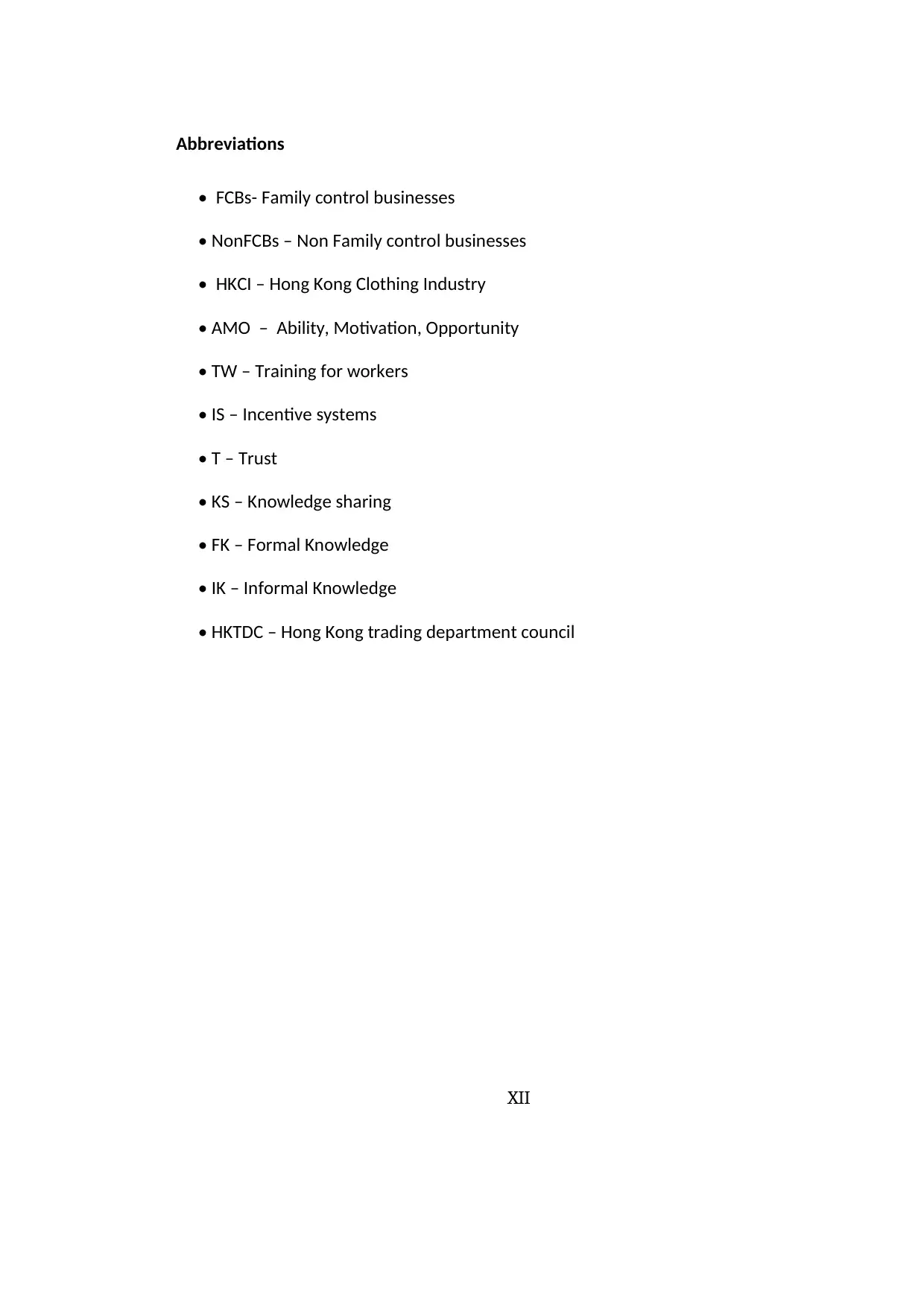
XII
Abbreviations
• FCBs- Family control businesses
• NonFCBs – Non Family control businesses
• HKCI – Hong Kong Clothing Industry
• AMO – Ability, Motivation, Opportunity
• TW – Training for workers
• IS – Incentive systems
• T – Trust
• KS – Knowledge sharing
• FK – Formal Knowledge
• IK – Informal Knowledge
• HKTDC – Hong Kong trading department council
Abbreviations
• FCBs- Family control businesses
• NonFCBs – Non Family control businesses
• HKCI – Hong Kong Clothing Industry
• AMO – Ability, Motivation, Opportunity
• TW – Training for workers
• IS – Incentive systems
• T – Trust
• KS – Knowledge sharing
• FK – Formal Knowledge
• IK – Informal Knowledge
• HKTDC – Hong Kong trading department council
⊘ This is a preview!⊘
Do you want full access?
Subscribe today to unlock all pages.

Trusted by 1+ million students worldwide
1 out of 228
Related Documents
Your All-in-One AI-Powered Toolkit for Academic Success.
+13062052269
info@desklib.com
Available 24*7 on WhatsApp / Email
![[object Object]](/_next/static/media/star-bottom.7253800d.svg)
Unlock your academic potential
Copyright © 2020–2025 A2Z Services. All Rights Reserved. Developed and managed by ZUCOL.





